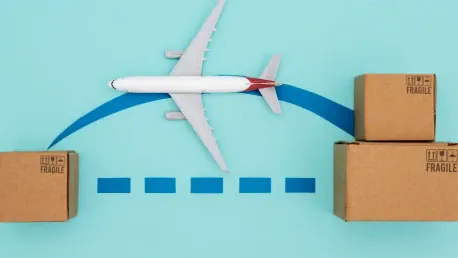The air cargo industry is poised for growth in 2025, driven by the increasing reliance on e-commerce volumes. However, this dependency brings both opportunities and challenges. Insights from Niall van de Wouw, Chief Airfreight Officer at Xeneta, shed light on the sector’s future, emphasizing the critical role of e-commerce and the potential risks associated with it.
Robust Performance in 2024 and E-Commerce Growth
The air cargo market experienced a strong performance in 2024, ending on a positive note. This growth was largely fueled by the booming e-commerce sector, which is expected to continue expanding at an annual rate of 14% until 2026. E-commerce has become a vital component of the air cargo industry, filling the gap left by a muted general freight market. The industry has been significantly influenced by this trend, as e-commerce continues to drive consistent demand.
Despite concerns over the global economic health and manufacturing signals, particularly from Europe, e-commerce has provided a consistent source of demand. This trend is anticipated to drive overall growth in the air cargo industry, offering a promising outlook for 2025. The air cargo market’s reliance on e-commerce has reshaped its dynamics, ensuring that it remains a key player in the industry despite various challenges. As e-commerce continues its upward trajectory, the air cargo industry must adapt and evolve to meet the growing demands and opportunities it presents.
Risks of Overreliance on E-Commerce
While e-commerce presents significant growth opportunities, it also poses potential risks. A downturn in e-commerce trade or regulatory crackdowns, especially on Chinese e-commerce platforms, could have a substantial impact on the market. The lack of an obvious alternative to replace these volumes adds to the uncertainty. Some stakeholders argue that the e-commerce market is nearing saturation, and various government regulations could further restrict growth.
These factors highlight the need for the air cargo industry to diversify its sources of demand to mitigate potential risks. The stability that e-commerce initially provided could become a double-edged sword if the market faces significant disruptions. Stakeholders must consider these potential impacts and explore strategies to diversify demand sources and reduce reliance on a single industry segment. By doing so, the air cargo industry can build resilience against possible downturns and ensure a more balanced and sustainable growth trajectory.
Impact of Ocean Freight Disruptions
The air cargo market has also been influenced by disruptions in ocean freight. The Red Sea crisis led to a modal shift from sea to air freight, raising questions about the longevity of this trend. Although recent strikes at U.S. east coast ports did not significantly boost air cargo volumes, other potential ocean freight issues could still drive shippers to airfreight for urgent shipments. This shift underscores the need for the air cargo industry to remain adaptable to sudden changes in the logistics landscape.
For instance, a three-day strike at U.S. ports in October resulted in a 12% jump in air cargo volumes. This indicates that while ocean freight disruptions may not always have a lasting impact, they can still create short-term opportunities for the air cargo industry. As global logistics continue to evolve, the air cargo sector must stay vigilant and prepared to capitalize on any shifts in demand. This adaptability will be crucial in maintaining its competitive edge and ensuring sustained growth in the face of potential disruptions.
Securing Capacity and Spot Rate Trends
Securing capacity to avoid high spot rates remains a critical concern for shippers and forwarders. Xeneta has encouraged stakeholders to secure capacity ahead of time, leading to a growing preference for longer-term airfreight contracts. In Q4 2024, contracts of one year or more accounted for 63% of agreements, a 16% increase compared to 2023. This trend highlights the importance of strategic planning and forward-thinking in securing stable and cost-effective airfreight solutions.
Despite this trend, nearly half of the volumes were still negotiated on the spot market, leading to potential revenue erosion due to rising airline rates. Spot rates have shown some stabilization, with a 15% year-on-year increase reflecting more market maturity. The strategic allocation of capacity pre-peak by airlines and securing capacity by freight forwarders and shippers have contributed to moderate spot rate increases compared to 2023. December 2024 saw a 15% rise in global air cargo spot rates to $2.99 per kg, the slowest growth rate in seven months. From September to December 2024, spot rates increased by 11%, compared to a 21% surge in the same period of 2023.
Regional Spot Rate Variations
Spot rates have varied significantly across different regions. In December 2024, the Europe-to-North America air spot rate experienced a 21% month-on-month increase, reaching $3.27 per kg, the highest in over two years. This rise was attributed to reduced cargo capacity due to airline winter schedules and the reallocation of freighter capacity to Asia. This variation illustrates the dynamic nature of the air cargo market and the need for stakeholders to remain adaptable to changing conditions.
In contrast, the Northeast Asia-to-North America corridor saw a modest 5% increase in December to $5.57 per kg, while the Northeast Asia-to-Europe market posted a 4% rise to $5.28 per kg. The China-to-US corridor showed a 9% decline from its mid-December 2024 peak of $5.61 per kg to early January 2025, influenced by changes in the e-commerce sector and strategic capacity allocation. These regional differences highlight the importance of understanding specific market conditions and trends to make informed decisions.
Cautious Optimism Amid Global Uncertainties
Although IATA predicted a 5.8% year-on-year rise in air cargo volumes for 2025, Xeneta estimated a smaller growth range of 4-6% in global air cargo demand. This growth is expected to outpace the global cargo capacity supply growth of 3-4%. However, air cargo stakeholders remain cautious due to several industry challenges. These industry challenges include a subdued manufacturing outlook, geopolitical tensions, potential Trump tariffs, stricter de minimis thresholds related to e-commerce, increased global security risks, and extreme weather or natural disasters.
These factors contribute to heightened market volatility, impacting air cargo demand and causing significant fluctuations in air freight rates. As the industry navigates these complex challenges, maintaining cautious optimism and strategic planning will be crucial for sustained growth. By staying informed about global trends and proactively addressing potential risks, air cargo stakeholders can better position themselves to weather uncertainties and capitalize on opportunities.
Adapting to Market Dynamics
The air cargo industry is expected to experience significant growth by 2025, primarily due to the burgeoning reliance on e-commerce. This surge in online shopping is anticipated to drive demand for air freight services, creating a myriad of opportunities while also presenting distinct challenges. According to Niall van de Wouw, Chief Airfreight Officer at Xeneta, e-commerce is set to play a pivotal role in shaping the future of the air cargo sector. It is clear that as more consumers turn to online platforms for their shopping needs, the volume of goods requiring swift transportation will rise correspondingly.
Nevertheless, there are inherent risks linked to this increased dependence on e-commerce. The sector must navigate issues such as fluctuating demand, supply chain disruptions, and the need for rapid adaptation to technological advancements. The future of air cargo, as foreseen by industry experts, lies in balancing these opportunities and challenges effectively. By capitalizing on the growth potential while addressing the associated risks, the air cargo industry can achieve sustainable development and innovation, ensuring it meets the demands of the evolving market landscape.









